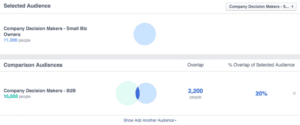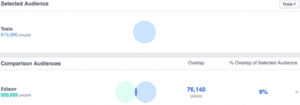So, you’ve created some spectacular looking custom Facebook audiences for your social media strategy. They’re exactly who you want your ads to reach, and there’s enough people to make your ads super effective…But something is off. You can’t quite put a finger on it. If the audiences are performing very similarly with both price and engagement. It might be that your audiences have a too much overlap. Now the question is, what to do?
Thankfully, Facebook has generously created a tool for us to measure your audiences’ overlap. Using this fun tool will ensure that your audiences are reaching distinctly different people so that you can make an impact with your online advertising and social media content. We’ve devised some social media tips on how to learn from the tool and use it to boost your social media performance. But first, let’s walk you through how to use the tool!
- Create an audience:

- Make it fun and detailed! We’re going to create two different ways to reach Decision Makers here in Nashville, Tennessee.
- Now that we’ve pulled our two separate audiences, we can now compare them using the audience overlap tool. Checkmark your two audiences.

4. Click on “Actions”and select “Show Audience Overlap.”

5. This will pull up the Audience Overlap tool. As you can see below, the two audiences that I have created have only a 20% overlap with 2,200 people being in both audiences.

At this point, you might be asking me, “Austin, what’s the point? What can we learn from this? How does this tool actually help me and my social media strategy?”
Hush, hush. This will all be explained in due time. Luckily, for you, the time is NOW!
When your audience has a lot of overlap, and you’re using the same ads for both, watch them extremely carefully. For example if you are advertising for a new comic book company, you might want to target the two heavy hitters of the comic book world: DC and Marvel.

When your audiences have a lot over overlap, like the two above, often times one of them will start to pull ahead in terms of cost per goal and reach. Now, this is where it’s important to take notes. Get your mental pen handy and mark this down. Are people responding the way you want them to? Which audience do you believe is performing better?
If DC comics performs better than Marvel, consider why. Is there something in your tone, or creative that is responding more to one and not the other? Pick apart your advertisements. Figure out what exactly works and resonates with your audiences. Then, once you there’s enough data to see which one is performing best, turn off the underperforming ad and reallocate your budget to the audience that is doing well. This ensures that you’re getting the most bang for your buck on Facebook.
If you feel that you’d still like to target the underperforming audience, separate it out, and target it with it’s own advertising in an attempt to pick up its engagement and reach. In separating the audiences with their own set of ads, it ensures that your money is being spent effectively to reach both audiences, and not giving you the muddy mix of the two.
This all changes when you have low audience overlap (less than 30%).Take the example below, for instance, if you’re looking to promote an underground inventor’s museum, you might want to promote to fans of popular inventors Nikola Tesla and Thomas Edison.

Now that you have two very specific and segmented audiences you need to take a look at the messaging that you’re providing in your ads. If your messaging is very broad, (i.e. “Our underground inventor’s museum is THE BEST! Click to learn more”) you can target both of these audiences together. If you have other specific marketing plans engaged, this would be a fine way to cover your bases and target those audiences. However, since they’re so unique, with only a 9% overlap of people, this is a great opportunity to get specific with your messaging so that your budget is better spent.
Here’s our pro-tip: split these audiences up. Write individual copy for Edison AND Tesla, this way, you can target Tesla people with specific messaging AND Edison people with specific messaging. Now, you can target with specific messaging about YOUR inventor, let’s call him, “Austin.” Talk about how Austin and Tesla worked on a project together back in the 1920s. Tie in their key interest with your messaging to really relate to these individual audiences. The inclusive messaging with the targeted ads will exponentially increase the response on your ads and maximize your budgets.
It’s official, now that you’ve read this article, you’re a master of the Facebook Overlap tool. When you’re targeting the same messaging to two different audiences with overlap of more than 30%, watch those ads VERY closely. If one audience starts to outperform the other, turn off the underperforming one and reallocate your budget. When your audiences have very little overlap (less than 30%) you have a choice to make. Targeting two unique audiences with the same message can muddy your results, but if you have extensive social media advertising campaigns running, this might work best for you. However, my suggestion would be to split the audiences up and use two separate advertising messages so that you can get the most bang-for-your-buck.
Now go-forth and bring your new-found Facebook Audience Overlap expertise to your small business’s social strategy! And if you need any more help, feel free to contact us!





